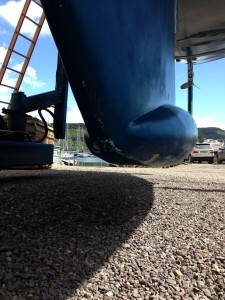Since bending our rudder in the bay outside Lagavulin distillery, I’ve had lots of time to ponder the whole event and realize the numerous errors – some ridiculously obvious – that I made… So for a little bit of self-flagellation, here’s the list (maybe it’ll help someone else…):
Before hitting rocks:
- Don’t enter a knowingly tight bay on a falling tide.
- Worse still, be aware of the tide conditions before entering the bay!
- Don’t enter a knowingly tight bay without best possible charts or instructions.
- If you’re not sure of the lay of the land inside a bay, and there’s nothing stopping you anchoring just outside safely, then the smart and seamanlike choice is to anchor outside the bay.
- Make sure your depth sounder is calibrated correctly and that you understand the datum.
After hitting rocks:
- Don’t give up on reversing gently off the rocks too quickly. Moving forward (just because it goes) is likely to land you higher and drier than before.
- Attempt to rock the boat as you reverse off.
- Don’t panic. The bumping, grinding and shaking of the mast are exceedingly frightening and distressing, but it all sounds far worse than it really is. The boat is most likely safer sitting on the rocks than being dragged off them.
- Have a second anchor ready to deploy.
- Deploy second (kedge) anchor via the dingy, off the stern – in the direction from which you came – maybe not such a good idea – see postscript.
- Failing a rearward kedge, attempt a sideways kedge, with anchor attached to stern and to a halyard in a bridle fashion. Lean the boat over as you’re pulling her out.
- If you accept a tow, attach to the stern and follow the direction in which you entered.
The damage done to Toodle-oo!’s keel and rudder bottom suggests that we could easily have sat there taking the horrible abuse and waited for the tide to turn and rise and simply float off. It was amazing to us both how minimal the damage was. Because we were mid tide and it was falling, it would have been a long painful wait – but if all other actions failed, it would most likely have been a far less damaging result than our final rescue was.
In chatting with the Workshop Manager at Ardfern Yach Center (where we await our new rudder), he indicates that most damage is done to boats when they are towed off rocks – not by being on them…
PS: It has been pointed out to me (thanks Paul Lever) that reversing out may not be the best approach – for fear of damaging the exposed rudder – and banging it past it’s stops. I agree with this… however, if only the keel has touched, if you can immediately come back the way you came in, I do think that would be best. We tried, but before getting any success, the boat pivoted – now we could not come back out the way we went in.
Paul also mentioned sounding around the boat to locate the deepest water. Great idea! This stupid fool even has a hand held depth finder for just such a purpose – but didn’t even think to use it – even up to now!


It’s amazing how intelligent we can all be with hindsight. But in the heat of the moment it’s so hard to get perspective! I really hope your new rudder arrives soon so you can have a lovely summer… although it looks like you’re both having a blast on land too.
Lots of love from downunder
Sarah, Tim and Matilda
xxx